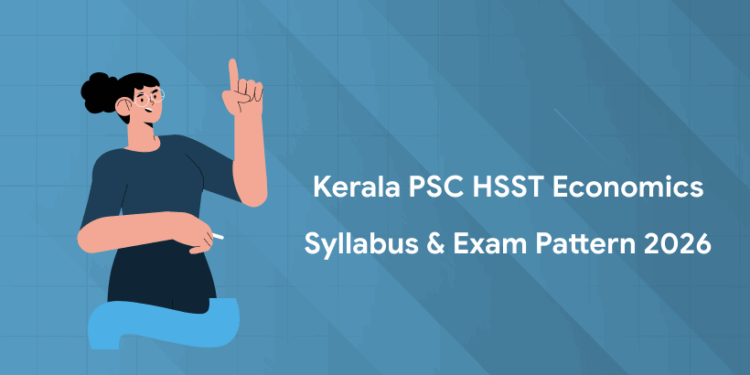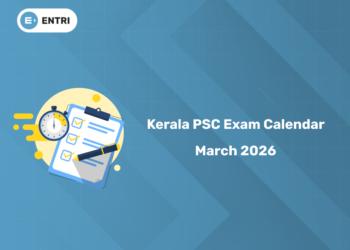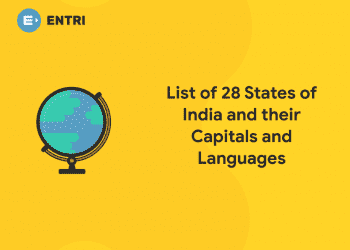Table of Contents
The Kerala Public Service Commission (KPSC) has released the detailed syllabus and exam pattern for the Higher Secondary School Teacher (HSST) Economics 2026 under the Higher Secondary Education Department. The exam will be OMR-based, carrying 100 marks, and divided into three parts. In this blog, we’ve provided the latest HSST Economics syllabus and exam pattern 2026 PDF. Download now!
Kerala PSC HSST Economics Recruitment 2026 Highlights
| Kerala PSC HSST Economics Notification 2026 | |
| Job Type | Government Job |
| Post Name | Higher Secondary School Teacher |
| Category Number | Notify Later |
| Subject | Economics |
| Notification Release Date | Notify Later |
| Application Starts | Notify Later |
| Apply Mode | Online |
| Last Date to Apply | Notify Later |
| Official Website | www.keralapsc.gov.in |
Kerala PSC HSST Economics Syllabus 2026 PDF Download
1: The first recipient of the ‘Rajiv Gandhi Khel Ratna’ award?
The full HSST Economics syllabus PDF is given in the attached link below. It includes all modules, topics, and exam details. Students can use it to plan their study and keep track of what to learn.
Enroll in Kerala's Top-rated HSA Coaching Program!
സർക്കാർ ജോലി എന്ന സ്വപ്നം ഇനി സ്വപ്നം മാത്രമല്ല! Join Entri's HSA Coaching Program
Join Now!Kerala PSC HSST Economics Exam Pattern 2026
| Part | Module(s) | Topics Covered | Marks |
|---|---|---|---|
| Part I | Module I – VII | Micro Economics, General Equilibrium, Macro Economics, Current Controversies, Indian Economy, Fiscal–Financial–External Sector Issues, Quantitative Methods | 70 Marks |
| Part II | Teaching Aptitude, Research Aptitude | Teaching methods, learner characteristics, research process, ethics, thesis writing, etc. | 10 Marks |
| Part III | Indian Constitution, Social Welfare Legislations & Programmes | Constitutional framework, rights, duties, emergency provisions, social welfare acts and programmes | 10 Marks |
| Part IV | Renaissance in Kerala, General Knowledge & Current Affairs | Kerala renaissance movements, reformers, press, literature, women’s role, and current affairs | 10 Marks |
| Total | — | — | 100 Marks |
Kerala PSC HSST Economics Detailed Syllabus 2026
Below is the detailed syllabus outlining the main topics, subtopics, and areas of study included in HSST Economics Exam 2026.
PART I
Module I – MICRO ECONOMICS (10 Marks)
Recent Developments in Demand Theory:
Pragmatic approach to demand analysis – Constant Elasticity demand function – Distributed lagged models of demand – Nerlove’s model – Houthakker’s and Taylor’s model – Linear expenditure system – Inter-temporal choice.
Consumer Behaviour under Uncertainty and Risk:
Measuring risk – risk lover – risk aversion – risk neutrality – St. Petersburg paradox – Neumann-Morgenstern Utility Index – Friedman-Savage Hypothesis – trade-off between risk and return – the investor’s choice problem – the household portfolio decisions under uncertainty – the state preference theory – Bandwagon effect – Snob and Veblen effect – Cob-Web theorem.
Theory of Production and Costs:
Short-run and long-run production function – Homogeneous production function – Linear homogeneous production function and CES production function – Technological progress and production function – labour deepening, capital deepening and neutral technical progress – Cost function – cost minimizing input choices – properties of cost function – Economies of Scale – Learning Curve.
Market Structure:
Perfect and Imperfect Market – Perfect Competition – Monopoly – Monopolistic Competition – Collusive and Non-collusive models – Oligopoly with homogeneous product and with non-homogeneous product – Chamberlin’s, Sweezy’s Kinked Models – Bertrand’s, Cournot, Stackelberg’s models – Duopoly.
Theory of Games:
Strategies – Zero-sum Game and Non-zero-sum Game – Prisoner’s Dilemma – Nash Equilibrium – Game Theory Applications – Issues in Game Theory.
Information Economics:
Asymmetric Information – The Market for Lemons – The Principal-Agent Problem – Moral Hazard – Adverse Selection – Screening and Market Signalling.
Theory of Distribution, General Equilibrium and Welfare Economics
Theory of Distribution:
Neoclassical approach to distribution – Marginal productivity theory – Product exhaustion theorem: Euler’s theorem and the ‘adding up’ controversy – Clark-Wicksteed-Walras product exhaustion theorem – Keynesian or Neo-Keynesian theories of distribution or Alternative distribution theories: Kaldor-modified model of Pasinetti – Alternative widow’s cruse models – Classical theory of distribution – The Ricardian model – Marxian theory – Modern theory of distribution or Post-Keynesian theory of distribution – ‘Degree of monopoly’ by Kalecki – Theories of wage – Theories of interest – Theories of profit.
Module II – GENERAL EQUILIBRIUM (10 Marks)
General Equilibrium:
Interdependence in the economy – Partial and General equilibrium – Walrasian general equilibrium – Two-factor, two-commodity, two-consumer general equilibrium model – Existence, uniqueness and stability of general equilibrium – Brouwer’s fixed point theorem.
Welfare Economics:
Criteria of old social welfare economics – Growth criteria – Cardinalist criteria – Bentham’s criteria – Pareto optimality – New welfare economics – Kaldor–Hicks compensation criteria – Scitovsky criteria – Social welfare function – Bergson-Samuelson – Arrow’s impossibility theorem – Pigouvian welfare economics – Point of bliss – Theory of second best – Rawlsian concept of justice – Coase theorem.
Marginalist Controversy and Managerial and Behavioural Theories of the Firm:
Hall & Hitch – Full Cost Pricing – Gordon’s attack on Managerialism – Bain’s Limit Pricing – Sylos Labini’s Limit Pricing – Baumol’s theory – Marris’ model – Williamson’s model – Cyert and March’s behavioural model.
Module III – MACRO ECONOMICS (10 Marks)
Aggregate Demand and Consumption Function:
Keynes’ Psychological law – Absolute & Relative Income Hypothesis – Kuznets’ consumption puzzle – Fisher’s Inter-temporal choice model – Permanent Income Hypothesis – Life Cycle Hypothesis – Investment Function – MEC & MEI – Neo-Classical Theory of Investment – Tobin’s q-ratio – Modigliani-Miller theory – Classical approach to demand for money – Quantity theory – Fisher’s equation, Cambridge Quantity theory – Keynes’ Liquidity Preference approach – Post-Keynesian approaches to demand for money – Friedman’s restatement of Quantity theory of money – Approaches of Baumol and Tobin – Supply of money – Money multiplier process – Behavioural and endogenous money supply model – Fisher effect.
Macro Economics in an Open Economy:
IS-LM analysis in an open economy – Foreign Exchange Market – Determination of Exchange Rates: Fixed vs Flexible – Pegging of the currency – Balance of Payments/Accounts – Disequilibrium in BOP – Depreciation, Appreciation, Revaluation, Devaluation, J-curve Effect – BOP in Keynesian analysis – Exchange rates – Money and capital flows in an open economy – Mundell-Fleming Keynesian Model – Monetary and Elasticity Approach to Balance of Payments.
Classical versus Keynesian Approach:
Classical: Labour market – Employment and output – Say’s Law – Interest rate – Neutrality of money and Classical Dichotomy.
Keynesian Fixed Price Models: Keynesian Cross model – Liquidity Trap – Fiscal and Monetary Policies – Crowding out Effect.
Labour Market:
Classical versus Keynes – Keynes Effect and Real Balance Effect.
Inflation:
Types – Causes – Inflationary gap – Demand pull and Cost push inflation – Phillips curve – Lipsey’s excess demand model – The Samuelson-Solow modification of the Phillips curve – Tobin’s views on Phillips curve – Strategies to control inflation and deflation.
Neo-Keynesian Analysis (Disequilibrium model):
Walrasian vs Keynesian models – Effective demand and National demand – Incompatibility of Walras Law and Neoclassical Synthesis of Keynes’ General Theory – Disequilibrium models of Robert Clower, Leijonhufvud, Barro-Grossman, and Malinvaud.
Module IV – CURRENT CONTROVERSIES IN MACRO ECONOMICS (10 Marks)
Keynesian Counter-Revolution:
Dual Decision Hypothesis – Walrasian General Equilibrium – Neo-Keynesian Quantity Constrained Model – Rational Expectations – New Classical Macro Economics – Supply Side Economics – Business Cycles: Measurement – Endogenous theories (Hicks, Goodwin, Kaldor) – Exogenous theories – Real Business Cycle Approach – Financial cycles (Minsky) – Growth cycles – New Keynesian Economics.
Macro Economic Policy:
Objectives of Macro Economic Policies – Target variable and Instrument variable – Main Policy Instrument – Monetary Policy vs Fiscal Policy – Okun’s Law – Budget Deficit – Debt dynamics – Domar instability condition – Ricardian equivalence – Monetarisation of the debt – Contemporary macroeconomic debates in India and the world – Crowding out Effect and Government Budget – Income Policy – Stabilisation Policy – New Cambridge Approach.
Theory of Demand and Supply of Money:
Classical and Keynesian approach to demand for and supply of money – Post-Keynesian approach – Real Balance Effect (Pigou, Patinkin, Baumol, Friedman and Tobin) – Arrow-Debreu model – Overlapping generation model of Samuelson – Cash-in-advance model of Clower – Monetarism and Fiscalism – Money supply in an open economy – High Powered Money – Money Multiplier – Control of money supply – Behavioural model of money supply – Endogenous money supply theory.
Module V – INDIAN ECONOMY (10 Marks)
Agriculture:
Performance since Independence across crops and zones – Institutional structure – Land reforms – Farm size and productivity – Agricultural inputs – Technological change in agriculture – Sustenance of agricultural growth – Green Revolution – Agricultural finance and credit – Role of co-operatives – Agricultural marketing and pricing – WTO and its impact on agriculture – Agrarian crisis – Food security – New Agriculture Policy.
Industry:
Growth and pattern of industrial development – Industrial stagnation (old and new debates) – Trends in industrial productivity – Industrial financing – Industrial policies – Privatisation and disinvestment – Cottage and small-scale industries – Globalisation and technology transfer – SEZ – ICT-based industrial development strategies.
Service Sector:
Sources of service sector growth – Infrastructure (physical and social) – Status and policies – Transport – Energy – Telecommunication – Technology – Information technology – Research and Development – Health and Education.
Module VI – FISCAL, FINANCIAL AND EXTERNAL SECTOR / ISSUES (10 Marks)
Fiscal Sector:
Fiscal deficit, trends and significance – Fiscal policies – Critical appreciation – Central-State fiscal relationships – Thirteenth Finance Commission: Major recommendations – Recent budgets (last 2 to 3 years) – Parallel economy.
Financial Sector:
Financial system – Banking and insurance – Capital markets – Critical appraisal of monetary and financial sector reforms – Financial inclusion – Analysis of price behaviour – Inflationary trends – Petroleum product pricing.
External Sector:
Structure and direction of India’s foreign trade – Balance of Payments (post-1990 trends) – Exchange rates and policies – India and WTO – EXIM policy – FII and FDI in India – Role of MNCs.
Economic Planning in India:
Planning and economic development – Objectives of planning – Techniques of planning – Achievements of planning – Bottom-up and Step-down approaches in planning – Evaluation of Five-Year Plans – NITI Aayog and its Vision Documents – Welfare programmes announced in the last two Union Budgets.
Economic Reforms Since 1991:
Background of economic reforms – Washington Consensus – Industrial policy reforms – Trade policy reforms – Fiscal policy reforms – Financial sector reforms – Foreign investment policy reforms – Second generation economic reforms – Appraisal of India’s economic reforms – Post-reform infrastructure investment models – PPP – Cooperative federalism with special reference to GST.
Kerala Economy:
Profile since formation – Model of development – Structural changes in Kerala economy – Demographic changes – Ageing – Health – Migration – Poverty – Unemployment – Transformation in labour culture – Migrant labour in Kerala – Social security of labour – Emerging issues and policies – Land reforms – Formation of SEZs – Kerala and WTO – Fisheries and plantation sectors – Land market in Kerala – People’s Plan – Role of Panchayati Raj – ICT and development – Tourism – Women empowerment – Role of microfinance – Privatisation and human capital formation – Kerala’s higher education – Environmental degradation – Fiscal crisis.
Module VII – QUANTITATIVE METHODS (10 Marks)
Measures of Central Tendency:
Mean – Median – Mode – Harmonic Mean (HM) – Geometric Mean (GM) – Weighted HM – Weighted GM.
Dispersion:
Range – Quartile Deviation (QD) – Mean Deviation (MD) – Standard Deviation (SD) – Skewness and Kurtosis – Correlation – Simple Linear Regression Analysis – Multiple Regression Analysis.
Linear Algebra:
Different types of functions and their graphs – Constant, Linear, Quadratic, Cubic, Polynomial, Exponential, and Logarithmic functions – Applications of linear functions in economics – Vectors and matrices – Determinants – Solution of a system of equations (Inverse method and Cramer’s rule) – Rank of a matrix – Characteristic equations, characteristic roots and vectors.
Probability Theory:
Concept of probability – Different approaches: Classical, Empirical and Axiomatic – Theorems of Probability: Addition and Multiplication Theorem – Conditional Probability – Bayes’ theorem – Random variables and probability distributions – Mathematical expectation.
Probability Distributions:
Discrete and Continuous distributions – Binomial, Poisson, Multinomial, Negative Binomial, Lognormal, Pareto and Normal distributions – Properties and applications.
Sampling Theory:
Population and sample – Sampling and sample designs – Theoretical basis of sampling – Methods of sampling – Parameter and statistic – Measurement and scaling techniques – Sampling distribution and standard error – Central Limit Theorem – Distribution of sample mean – Student’s t, Z, χ² and F distributions.
Theory of Estimation:
Point estimation and interval estimation – Properties of a good estimator – Testing of hypothesis – Null and alternative hypothesis – Type I and Type II errors – Critical region – Level of significance – Power of a test – Procedure of testing of hypothesis – χ² Test of goodness of fit – χ² Test for independence – Tests of significance for attributes – Tests of significance for large and small samples – Analysis of variance techniques – F test and ANOVA – One-way and Two-way classification.
Analysis of Variance (ANOVA):
Meaning, assumptions – One-way and Two-way classifications – Simple applications.
Allocation Models:
Linear Programming Problem (LPP) – Formulation of LPP – Solution of LPP using graphical and simplex methods – Big M method for solving LPP involving surplus variables – Duality in LPP, its properties and interpretation – Shadow prices.
PART II
RESEARCH METHODOLOGY / TEACHING APTITUDE
I. TEACHING APTITUDE (5 Marks)
- Teaching: Nature, objectives, characteristics and basic requirements.
- Learner’s characteristics.
- Factors affecting teaching.
- Methods of teaching.
- Teaching aids.
- Evaluation systems.
II. RESEARCH APTITUDE (5 Marks)
- Research: Meaning, characteristics and types.
- Steps of research.
- Methods of research.
- Research ethics.
- Paper, article, workshop, seminar, conference and symposium.
- Thesis writing: its characteristics and format.
PART III
Salient Features of Indian Constitution (5 Marks)
Salient features of the Constitution – Preamble – Its significance and its place in the interpretation of the Constitution.
Fundamental Rights – Directive Principles of State Policy – Relation between Fundamental Rights and Directive Principles – Fundamental Duties.
Executive – Legislature – Judiciary – Both at Union and State Level – Other Constitutional Authorities.
Centre-State Relations – Legislative, Administrative and Financial.
Services under the Union and the States.
Emergency Provisions.
Amendment Provisions of the Constitution.
Social Welfare Legislations and Programmes (5 Marks)
Social Service Legislations like Right to Information Act, Prevention of Atrocities against Women & Children, Food Security Act, Environmental Acts etc. and Social Welfare Programmes like Employment Guarantee Programme, Organ and Blood Donation etc.
PART IV
RENAISSANCE IN KERALA (5 Marks)
TOWARDS A NEW SOCIETY
Introduction to English education – Various missionary organisations and their functioning – Founding of educational institutions, factories, printing press etc.
EFFORTS TO REFORM THE SOCIETY
(A) Socio-Religious Reform Movements
SNDP Yogam, Nair Service Society, Yogakshema Sabha, Sadhu Jana Paripalana Sangham, Vaala Samudaya Parishkarani Sabha, Samathwa Samajam, Islam Dharma Paripalana Sangham, Prathyaksha Raksha Daiva Sabha, Sahodara Prasthanam etc.
(B) Struggles and Social Revolts
Upper cloth revolts, Channar agitation, Vaikom Sathyagraha, Guruvayoor Sathyagraha, Paliyam Sathyagraha, Kuttamkulam Sathyagraha, Temple Entry Proclamation, Temple Entry Act, Malayalee Memorial, Ezhava Memorial etc.
Malabar riots, Civil Disobedience Movement, Abstention Movement etc.
ROLE OF PRESS IN RENAISSANCE
Malayalee, Swadeshabhimani, Vivekodayam, Mithavadi, Swaraj, Malayala Manorama, Bhashaposhini, Mathrubhoomi, Kerala Kaumudi, Samadarsi, Kesari, Al-Ameen, Prabhatham, Yukthivadi etc.
AWAKENING THROUGH LITERATURE
Novel, Drama, Poetry, Purogamana Sahithya Prasthanam, Nataka Prasthanam, Library Movement etc.
WOMEN AND SOCIAL CHANGE
Parvathi Nenmenimangalam, Arya Pallam, A. V. Kuttimalu Amma, Lalitha Prabhu, Akkamma Cheriyan, Anna Chandi, Lalithambika Antharjanam and others.
LEADERS OF RENAISSANCE
Thycaud Ayya Vaikundar, Sree Narayana Guru, Ayyan Kali, Chattampi Swamikal, Brahmananda Sivayogi, Vagbhadananda, Poikayil Yohannan (Kumara Guru), Dr. Palpu, Palakkunnath Abraham Malpan, Mampuram Thangal, Sahodaran Ayyappan, Pandit K. P. Karuppan, Pampadi John Joseph, Mannathu Padmanabhan, V. T. Bhattathirippad, Vakkom Abdul Khadar Maulavi, Makthi Thangal, Blessed Elias Kuriakose Chavara, Barrister G. P. Pillai, T. K. Madhavan, Moorkoth Kumaran, C. Krishnan, K. P. Kesava Menon, Dr. Ayyathan Gopalan, C. V. Kunjuraman, Kuroor Neelakantan Namboothiripad, Velukkutty Arayan, K. P. Vellon, P. K. Chathan Master, K. Kelappan, P. Krishna Pillai, A. K. Gopalan, T. R. Krishnaswami Iyer, C. Kesavan, Swami Ananda Theerthan, M. C. Joseph, Kuttippuzha Krishnapillai and others.
LITERARY FIGURES
Kodungallur Kunhikkuttan Thampuran, Kerala Varma Valiyakoyi Thampuran, Kandathil Varghese Mappila, Kumaran Asan, Vallathol Narayana Menon, Ulloor S. Parameswara Iyer, G. Sankara Kurup, Changampuzha Krishna Pillai, Chandu Menon, Vaikom Muhammad Basheer, Kesav Dev, Thakazhi Sivasankara Pillai, Ponkunnam Varkey, S. K. Pottakkad and others.
GENERAL KNOWLEDGE AND CURRENT AFFAIRS (5 Marks)
General Knowledge and Current Affairs.
How to Download Kerala PSC HSST Economics Syllabus 2026 PDF
- Go to the official Kerala PSC website – https://www.keralapsc.gov.in
- Click on the “Downloads” tab from the main menu.
- Select “Syllabus” from the dropdown list.
- Choose “OMR Based Syllabus” from the options.
- Find and click on “HSST Economics” from the list of subjects.
- The Syllabus PDF will open — click Download or Save to keep a copy












